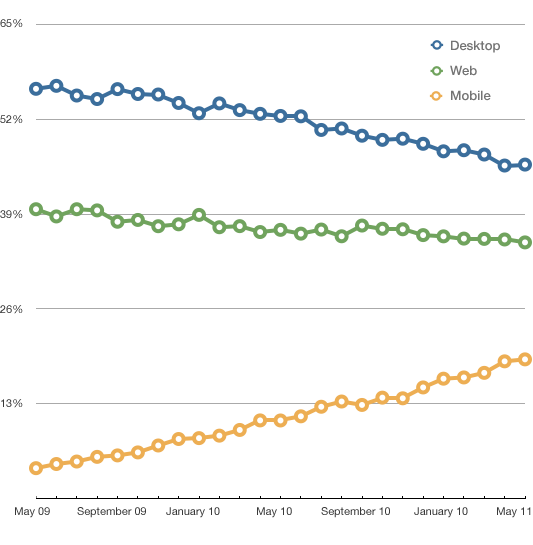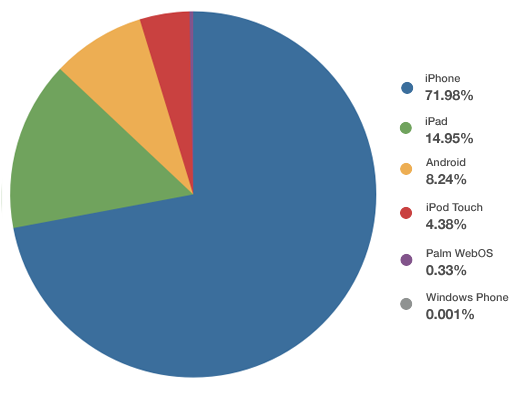A lot has changed in the mobile world since the days of the Nokia bricks, PDAs and the advent of the flip. Our devices are now half the size and exponentially more powerful. With increased network speeds, advanced operating systems and incredible storage capacities, today’s smartphones are exactly that—smart. Just watch the latest iPhone commercial and try to deny it.
So this may not come as a surprise: one in five emails is now read on a phone.

The number of people accessing email on mobile platforms is on the rise. This isn’t necessarily surprising—there are simply more capable devices, with more people paying for network access, and the email clients are easier than ever to set up.
But David Greiner, co-founder of CampaignMonitor, says it’s the magnitude of the rise in mobile email that is a bit surprising.
In June, Greiner tapped into CampaignMonitor’s client data to better understand the distribution of desktop, web, and mobile email clients (check out the full 2011 report). The experiment collated data from over 3 billion email receipts and produced some interesting results:
 The data suggests that desktop clients are still dominant, but their presence has declined about 12% over the past two years. The web client usage also appears to have declined, but only by about 4%. And clearly, mobile client usage is surging. Over the past two years, people accessing email through mobile clients has increased from a mere 4% to nearly 20%–largely at the expense of the desktop clients.
The data suggests that desktop clients are still dominant, but their presence has declined about 12% over the past two years. The web client usage also appears to have declined, but only by about 4%. And clearly, mobile client usage is surging. Over the past two years, people accessing email through mobile clients has increased from a mere 4% to nearly 20%–largely at the expense of the desktop clients.
While the trend is undeniable, it’s worth noting that the rise may not be quite as strong as the graph suggests. CampaignMonitor can only detect the email client if images are displayed, so email clients that display images by default are inflated (i.e. Outlook 2000 and the iPhone) and those that block images by default are underrepresented (i.e. Gmail and Outlook 2007). Even so, the rise of mobile is clear.
The Mobile Email Client Market
The explosion of mobile emailing in the past few years is largely attributed to the rapid adoption of smartphones and other network-enabled gadgets, like the iPad. Two years ago, the iPhone 3G was only recently released, the iPad didn’t exist yet, and the Android platform was only beginning to take off. But by Christmas, it’s estimated that 1 in every 2 Americans will have a smartphone.
Here’s the breakdown of the mobile email client market share based on CampaignMonitor’s data:
 This does not include data from the Blackberry and Windows Phone mobile clients because they also block images by default. But the chart nonetheless offers a decent diagnosis of the mobile market and clearly suggests that a lot of people use email on their iPhone—or at least about 1 in 5 people do.
This does not include data from the Blackberry and Windows Phone mobile clients because they also block images by default. But the chart nonetheless offers a decent diagnosis of the mobile market and clearly suggests that a lot of people use email on their iPhone—or at least about 1 in 5 people do.
Implications
The rise in mobile email has two major implications to consider. First and foremost, standard email design must be reconfigured to ensure that people on mobile clients have a similar reading experience. Fortunately, the mobile clients offer great CSS support, so modifying a template to adapt to a smaller screen isn’t too difficult. In one Greiner’s other posts, he presents a walkthrough of how CampaignMonitor tweaked their template based on simple mobile design tenants. He says that all you have to do is throw in an @media query, adjust the content width, and hide some of the less important stuff. But for those less tech savvy, he also provides the new CampaignMonitor template to download and mess around with.
Secondly, the rise in mobile email presents the need for mobile email tools. People have become accustomed to robust desktop and web email management applications—think Boomerang and Rapportive. And now that mobile email clients are being used so heavily, the tools need to be available on the mobile platforms as well. Here at Baydin we recognize the demand for mobile tools, so we launched Boomerang Mobile a few weeks ago to make the tools available on the go. Check it out now and let us know what you think!

